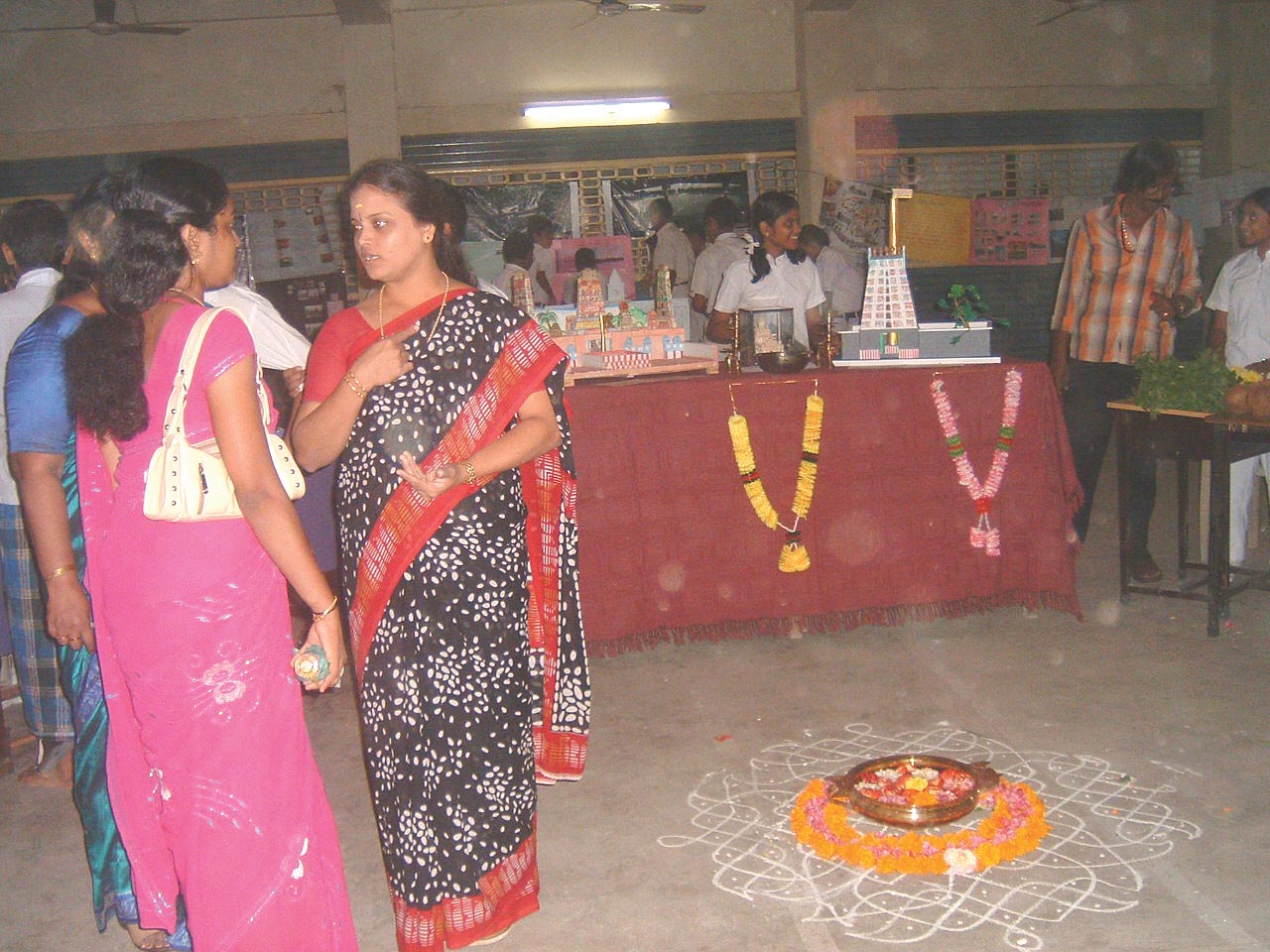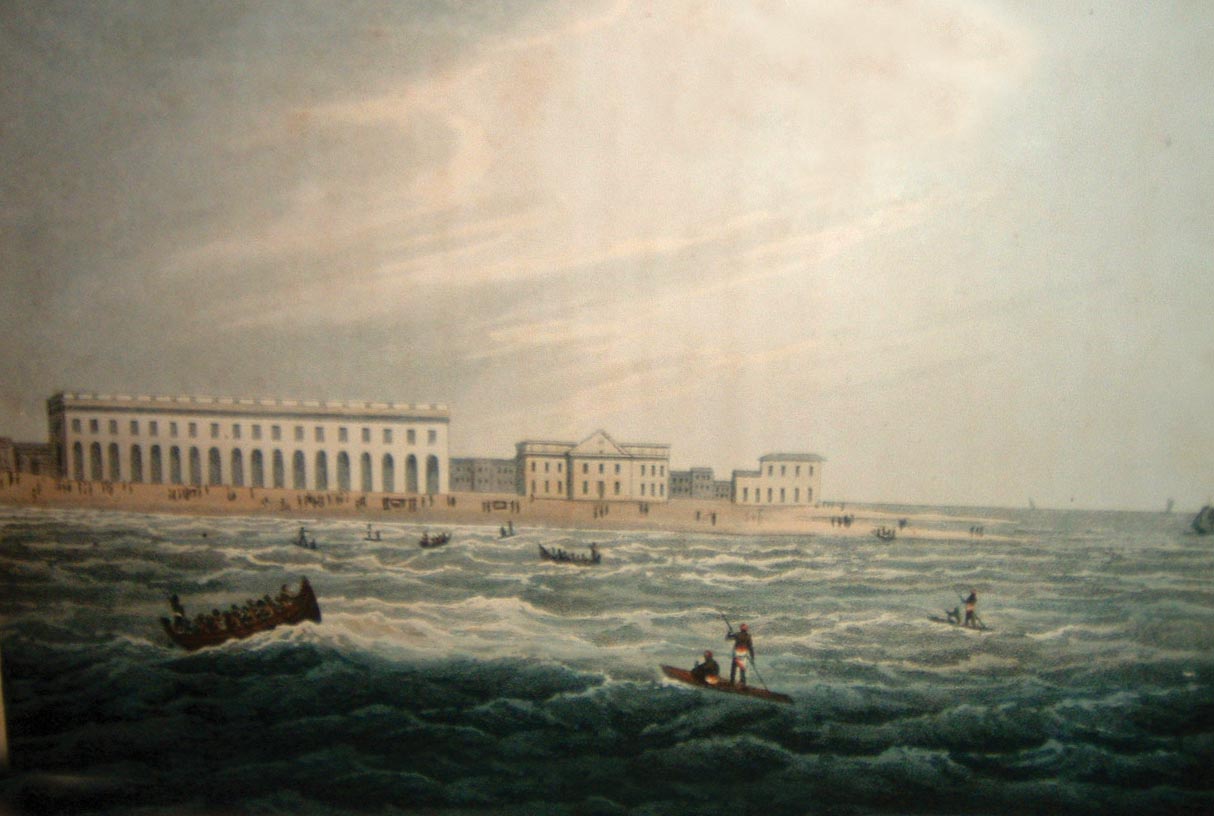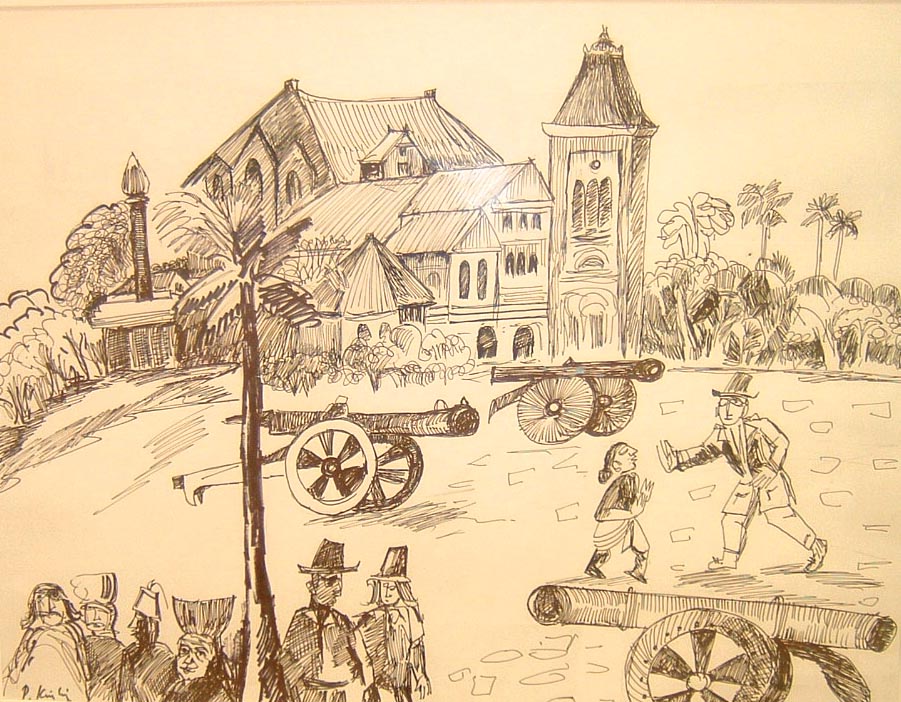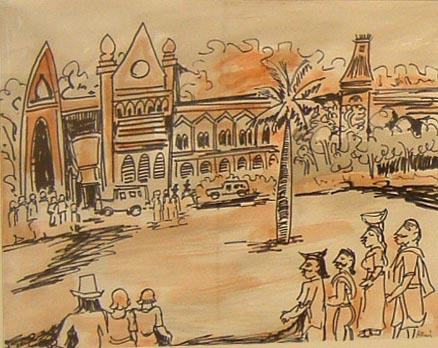
Asan Memorial School energetically celebrating Madras Week

Government House, left and Banqueting hall right

Customs House from the Sea


Sketches by P. Krishnakumar on diplay at Gallery Sri Parvati
|
Old homes
Madras Week could not have got off to a better start than with the release of Sriram V.’s book, Historic Residences of Chennai, which features 50 heritage homes that survive in the city against all odds.
The book is a free-for-distribution publication brought out by Kalamkriya Limited, part of the Sanmar Group, that has been in the forefront in the fight for conservation of heritage in Chennai.
B. Vijayaraghavan, a former bureaucrat but now focussed on our natural heritage and snakes in particular, released the book in front of a packed audience at the Connemara and said that having a Heritage Act alone is not enough; there are likely to be many issues that cannot be decided easily-for example, which buildings would you protect and which would you exclude? He pointed out that Government prefers to put heritage on the back burner and stressed the need for a sustained campaign by heritage-lovers and people in general to produce lasting results. He added that today’s generation is more at home with shopping malls and multiplexes than with heritage. A pertinent point, I thought.
S. Muthiah, Editor of Madras Musings, received the first copy of the book. In spite of fighting many a losing battle all these years, he urged more people to come forward in support of heritage conservation.
Sriram, of course, was as irrepressible as ever. The reasons he described for old bungalows in Chennai facing the hammer were hilarious and had the audience in splits. As Muthiah mentioned, it was good to see Sriram veering a little from Carnatic music to a broader canvas.
Student effort
Asan Memorial School kick-started its Madras Week celebrations with an exhibition of pictures and some exhibits of a Madras gone by. Randor Guy, inaugurating the exhibition, spoke about the Madras of old when you could have two idlis and two vadas for three paise!
It was heartening to see that many of the students had taken the trouble of making charts and collecting information about old Madras. The enthusiasm shown by Suma Padmanabhan, Principal, was commendable indeed. Weeks earlier, she, like last year, had put in place a team of students to oversee the celebrations. If only there were more school principals like her!
Madras gone by
At Lakshmy Venkataraman’s Gallery Sri Parvati on Eldam’s Road, the exhibition titled, ‘Madras Impressions: 18th-20th century’ featured P. Krishnamurthy’s sketches based on his memories of the Madras of his youth as well as of impressions he had gathered over the years from his research for historic films. Krishnamurthy is a contemporary of veterans like Adimoolam, Bhaskaran, Vasudev and Viswanadan. He was also closely associated with theatre some years ago and his friends included people like Girish Karnad, Karanth, Gopalie and Na Muthuswamy. It was purely by accident that he did the art direction for the film Hamsa Geethe in 1972. Since then he has done art direction for numerous films and documentaries.
Gallery Sri Parvati is a testament to heritage consciousness. It is a 1930s heritage home that has been refurbished. Those who have old homes would do well to take a leaf from owner Lakshmi Venkataraman’s book.
After Soundarya Nursery shifted, P.S. Venkataraman, a builder, established his home in the 4½ grounds of 33 (now 28/160) Eldams Road in 1935. It was a typical old-fashioned home, a screen dividing the big hall into two sections. Rajammal, Venkataraman’s wife, would tend the banana and mango trees and feed the cows in the cowshed. This was where their daughter Lakshmi grew up and spent the first 40 years of her life. When the home became her.
She decided against pulling it down and, instead, restored the building and turned it into a cultural centre. Part of the ground floor is let out as office space.
Early Madras
‘The Early Portraits of Madras – Etchings, Engravings and Aquatints’, mounted by the C.P. Art Centre in its Art Gallery, will surely rank as one of the finest exhibitions of pictures of old Madras we’ve had in the city. For easy reference and to provide a little background to the pictures from his collection, V. Narayan Swami had written a most useful booklet.
The exhibits, works of British and European artists showcased the life and times of the people between 1750 and 1850. But many of the artists, according Narayan Swami, did not travel to India but relied on descriptive accounts of the coast given to them by others.
The earliest known view of Madras, of Fort St George seen from the sea in 1731-32, was by George Lambert and Samuel Scott but was not included in the display. The next early view of Madras (a view of the fort as it existed at the time) was in 1754, a drawing by Jan van Ryne, a Dutch artist working in London.
From the 1750s began the extensive recording of landscapes, people, flora and fauna by the British residents in India and by visiting artists. There arrived a succession of artists, including William Hodges, the Daniells, Henry Salt and B. Henry.
Hodges lived in Fort St. George for a year and he drew some fine views of Tamil country. Thomas and William Daniell, uncle and nephew, toured India for eight years, from 1786 to 1794. In 1792, when they were in South India, they spent four months in Madras and produced a set of six drawings. All six found a place in this display. Included in the display also were drawings of John Goldingham, of the Banqueting Hall of Government House (Rajaji Hall) and of Government House itself (such a shame it has been pulled down!).
There were also a couple of maps on display, one from the time of the French siege of Madras in 1758-59 and the other of the jahgir lands of the East India Company in Madras in 1794.
An invaluable book
Thanks to the C.P. Ramaswami Aiyar Foundation and to its honorary director Nanditha Krishna’s efforts, Prof. K.V. Raman’s book The Early History of the Madras Region has seen the light of day once again. Amudha Nilayam first published the book in 1959 and this is the second print. Raman was Professor of Ancient History and Archaeology at the University of Madras and his book focusses on Madras’s history before the arrival of Francis Day and Andrew Cogan. As K.A. Nilakanta Sastri states in foreword, Raman has aimed at “presenting as continuous and complete a narrative of the history of the region as is possible now from the time man began to inhabit it right down to the middle of the seventeenth century A.D.”
Prof. Raman mentioned the inscriptions he had found in areas like Tiruvottriyur, a place he stressed must be visited by any serious student of Madras history. So are areas like Mylapore and Triplicane, each a cluster of villages in those days.
This invaluable book must form a part of every student’s study of the history of Madras, said S. Muthiah, the chronicler of Post-East India Company Madras, after releasing Raman’s book. But would it, he lamented, considering the lack of interest being shown towards the study of humanities in much of India today, and particularly Tamil Nadu. Subjects like history, geography and civics are given short shrift these days and unless these subjects are given their due and students themselves make efforts to study detailed histories of districts and regions, there is little hope for heritage, he said.
Wildlife, through puppets
‘Spring into Reading’, an activity centre for children in K.K. Nagar, conducted two programmes at Hotel Green Park. The first was a puppet-making programme titled ‘Wildlife of Chennai’. Bhanumathy, who runs the Pavai Centre for Puppetry, conducted for children in the 5-12-year age group an interesting session on simple puppet-making based on Chennai’s wildlife to create awareness in the children about wildlife in and around Chennai, its importance as natural heritage of the city, and their role in protecting and conserving such heritage.
When Binita and Shrimathi of ‘Spring into Reading’ and Bhanumathi together planned the event, they never expected the sort of response they received. Over 60 children arrived with parents in tow long before the scheduled time of the event. It was wonderful to see the young joyous faces, beaming smiles and the brimming energy that the children displayed on the floor – drawing, colouring and painting puppets.
The second programme was a thematic dance presentation, ‘Chennai is the Cultural Capital’, by Sheela Unnikrishnan and her troupe. Sheela, a dance teacher in Padma Seshadri School, K.K. Nagar, is the director of Sridevi Nrithyalaya. Anusha, Aswati, Harish and Deepak effortlessly waved through dance a story around Chennai, traversing some of the city heritage spots. The dances fitted in well.
In an interlude, Srijith, Sheela’s son, played the mridangam as Gayatri sang.
A Chef Amsa special
Chef Amsa Raju of Hotel Green Park, Vadapalani, was determined to do something special during Madras Week, and the result was a three-day food festival, ‘Cuisines of the Madras Presidency – A Journey into the Past’. The festival attracted record crowds. Chef Amsa’s sora puttu and the mini dosa were hits, and he relied on his mother’s, grandmother’s and wife’s recipes.
Sketches and pictures of old Madras provided just the right setting and, judging by the success of the festival, I’m certain General Manager Krishna Kumar must be looking forward to 2009.
Breath of fresh air
It is not the easiest of things to do on a Sunday morning – getting up early to set off on a tree walk in the Government Museum campus. Usha from Nizhal greets us at the entrance to the Museum complex.
Prasad, a local resident and once early morning walker in the Museum compound (the Museum authorities have now stopped morning walker), was the first to arrive.
Madras Narasimhan Pushpa, botanical curator at the Museum, is a fund of knowledge – you can probably ask her anything you want to know about flora and the chances are you will get an answer. The Government Museum premises in Egmore, spread over 16 acres, has the largest variety of plants and trees in Chennai, she says. Women’s Christian College has the second largest, in its campus of 20 acres.
I have never before been to the rear of the Museum. As we trudge slowly beneath the tree canopy, it almost seems as if we are walking into a forest. A large colony of bats greets us with shrieks and flutter of wings, as Pushpa stops by to explain a thing here and something there. They are obviously not used to human noises so early morning. Prasad confirms that the early morning walkers usually receive no such greeting from the bats. So it must be our chatter.
|